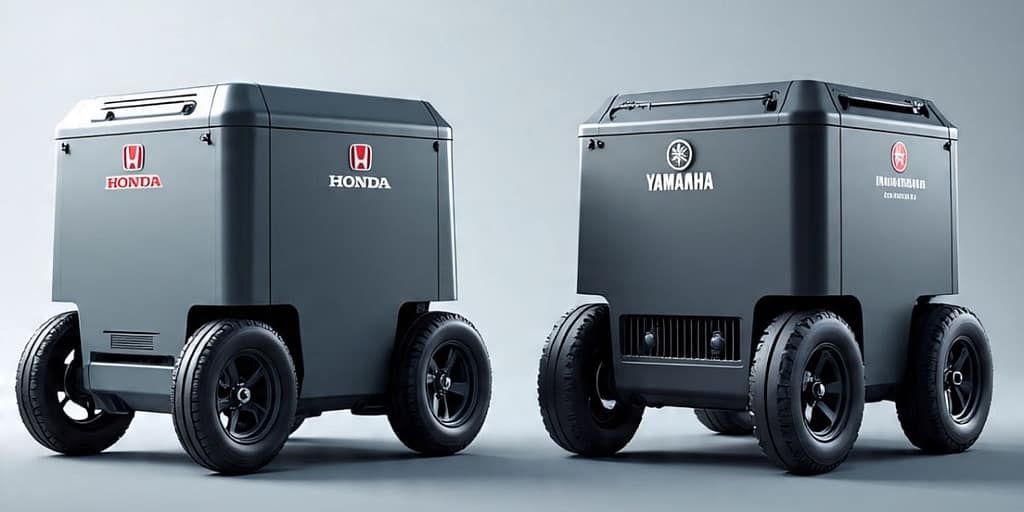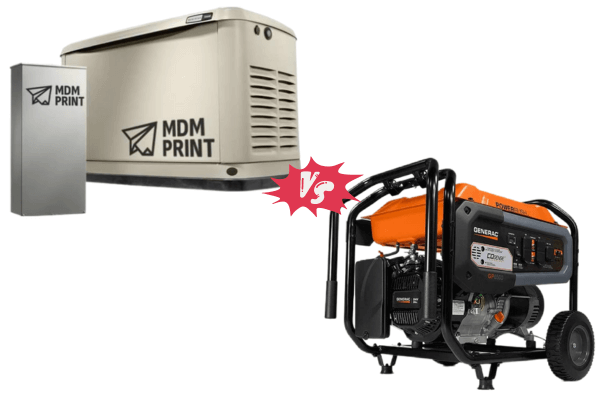I’ve spent the last few weeks testing two compact inverter generators side by side—the PowerSmart 2500W and the Erayak 2400P. Both are marketed as lightweight, quiet, and fuel-efficient power solutions for camping, tailgating, and emergency backup. On paper they look similar, but once you actually unbox them, carry them around, and run them under real loads, the differences start to show.
In this review I’m not just listing specs; I’m sharing what it’s actually like to use each generator in real situations—hauling them to a campsite, plugging in a fridge, charging electronics, and running them overnight. From design and build quality to power output, runtime, control panels, and noise levels, I’ve compared every key detail to help you decide which one fits your needs best.
Design and Build Quality

I’ve had the chance to get hands-on with both the PowerSmart 2500W Inverter Generator and the Erayak 2400P Portable Inverter Generator, and the differences in design and build quality really stand out once you handle them side by side.
The PowerSmart 2500W is clearly designed with portability and basic functionality in mind. At around 39 lbs, it’s light enough to move around without breaking a sweat, and its compact footprint (18.1″ L × 12.6″ W × 18.7″ H) makes it easy to store in a garage or pack in the back of an SUV for camping trips. The carry handle on top is solid and does its job, but it’s pretty barebones—no ergonomic padding or extra contouring, so it can get a bit uncomfortable if you’re hauling it for a longer distance. The overall construction feels decent for the price: a steel frame beneath a plastic outer shell that’s sturdy enough for routine use but not as rugged as some higher-end competitors. The control panel is simple and functional with clearly labeled outlets and switches, though it lacks any sort of advanced digital display or runtime info you’d find on premium models. It’s more of a “no-frills but works” approach.
On the other hand, the Erayak 2400P really surprised me the first time I took it out of the box. I’ve reviewed the bigger Erayak 4500W before, so I already had high hopes, but the build quality here feels even tighter for its size. The casing has a thick, durable feel with zero flex or creaks when you press on it—definitely not one of those thin plastic shells that feel like they’ll crack if you bump them. Even the seams are clean, with no rattling parts inside. It’s also super compact (13.7″ H × 9.7″ D × 7.7″ W), which makes it really easy to tuck into small spaces. Carrying it is no problem at all thanks to the big, well-balanced handle that doesn’t dig into your fingers, even when you’re walking a bit of a distance.
Design-wise, the Erayak is a standout. The bold red-and-black color scheme gives it a modern, industrial look without feeling flashy or cheap. The control panel is laid out very smartly: nothing cramped, everything labeled clearly, and the rubberized outlet covers are a thoughtful touch for keeping out dust and moisture. It even comes with USB ports alongside the AC and DC outputs—a nice bonus if you’re charging phones or small devices on the go. The switches and knobs feel high-quality, with a solid click and smooth turn, and the LCD display showing voltage and runtime info is something I’ve come to really appreciate when managing power usage.
Another small but noticeable detail: the Erayak’s ventilation is well designed. Air flows efficiently without making the unit bulky, and it doesn’t run hot under load. The rubber feet on the bottom also make a difference—they keep it stable on uneven surfaces and cut down on vibration noise. These small touches add up to a generator that feels like it’s been designed for real-world use, not just to hit a price point.
Bottom line: the PowerSmart 2500W is a practical, budget-friendly option with a straightforward design and decent build quality, but the Erayak 2400P feels more premium, more thoughtfully designed, and more robust. If design and build quality are priorities for you, the Erayak edges ahead.
Engine & Performance
The PowerSmart 2500W runs on an 80cc OHV engine. It starts up easily and runs smooth. The auto-throttle really works—you can hear the engine slow down when the load is light, and then kick up instantly when you plug in something heavier. That saves gas and keeps the noise low. I liked how cool it stayed even after a few hours. The low-oil shutdown is a real safety net; mine shut off once when I forgot to check the oil, and nothing got damaged. It’s not flashy, but it’s reliable and fuel-efficient. I don’t have to babysit it.
The Erayak 2400P is powered by a 79.7cc 4-stroke OHV gasoline engine, and in my experience it typically starts smoothly, often within the first or second pull. Once running, it’s smooth and steady—no weird surges or vibrations. Eco Mode keeps the engine quiet and sips fuel when I’m just charging small stuff. It only gets louder when the load gets heavy, but it’s still not obnoxious. I’ve run it for hours powering tools and essentials without overheating or dropping power. Being a 4-stroke, there’s no fuel-oil mixing—just fill and go.
Both engines feel solid in real use. The PowerSmart is a reliable performer with an impressive automatic throttle system. The Erayak feels slightly more refined and just as capable, with easy starts and smooth running.
Power Output
The PowerSmart 2500W gives you 2,500 starting watts and 1,900 running watts. In my tests it handled a fridge, LED lights, and power tools with no trouble. The circular saw surge didn’t even slow it down. Fuel efficiency is a real standout. In Eco Mode the fuel gauge barely moved after hours of use. I got close to 8 hours on one tank at moderate load. It’s not loaded with extras, but the power is steady and reliable. For me it hits that sweet spot—enough juice for most jobs without draining fuel or the wallet.
The Erayak 2400P delivers 2,400 watts at startup and sustains 1,800 watts during operation. For its size, that’s impressive. I ran a small space heater and mini fridge at the same time and it didn’t blink. The inverter output is clean—no flickering lights or humming electronics. I’ve charged my phone, laptop, and even run a TV on it, all smooth like grid power. It’s compact but delivers real usable power.
Side by side, the PowerSmart edges ahead slightly on wattage and runtime, while the Erayak impresses with clean, stable power in a smaller package. Both do what they promise, but each has its own strength.
Run Time & Fuel Capacity
The PowerSmart 2500W has a 1.05-gallon fuel tank. At light load (about 25%), I consistently got around 11 hours of runtime. That’s enough to keep lights, a fan, and phone chargers going all night. At 50% load the runtime dropped to about 5.5 hours, still solid for a medium fridge plus electronics. ECO Mode works quietly in the background, adjusting the engine speed without me having to think about it. It’s not the longest-running generator in the class, but for the size and weight the efficiency feels spot-on.
The Erayak 2400P has a slightly smaller 0.95-gallon tank but surprised me with how far it goes. With ESC (Economy) Mode on, I’ve had it run up to 14 hours at a low load. That’s perfect for overnight use at a campsite—no refueling or mid-night checks. It automatically slows the engine when the load is light, saving fuel and cutting noise. Even under heavier loads it still sips fuel compared to other small inverters I’ve used.
When compared directly, the PowerSmart offers a bit more output and steady runtimes across various loads. The Erayak, on the other hand, squeezes impressive hours out of its smaller fuel tank thanks to its smart speed control, making it exceptionally fuel-efficient. Both models perform well, but the Erayak seems built for maximum quiet and overnight use, while the PowerSmart leans toward longer operation with its slightly larger tank.
Control Panel
The PowerSmart 2500W keeps things simple. The panel is laid out cleanly with clear LED lights for CO alarm, low oil, overload, and running status. Those lights are easy to see at a glance and help prevent damage or unsafe conditions. The power switch is front and center—Off, On, and Eco Mode are right there. Two USB ports, a 12V DC outlet, and a standard 120V household outlet cover the basics. It also includes a parallel connection option for linking a second unit to boost output. The setup is simple and intuitive—no complex displays or hour counters, just the basics. Perfect if you prefer straightforward controls, but if you’re after detailed digital readouts, you may find yourself wishing for a screen.
The Erayak 2400P comes across as a noticeable upgrade in ease of use. Everything is clearly labeled and spaced out so nothing feels cramped. The small backlit digital screen is a big plus—it shows voltage, frequency, and runtime. I can see exactly how much I’m pulling and how long I’ve been running without guessing. It also has status lights for low oil, overload, and ready-to-go power. Two 120V AC outlets with rubber covers keep dust and moisture out, plus a 12V DC outlet that topped off my RV battery without a hitch. The USB ports are genuinely handy—I used them constantly for phones and speakers. Parallel ports are there too if I ever need them.
The controls themselves feel solid. Switches click positively, the eco-mode button works seamlessly, and the reset button got me back online instantly after an overload. Everything’s where it should be; nothing feels flimsy.
Placed next to each other, the PowerSmart provides a straightforward, no-frills layout that simply does the job, whereas the Erayak brings a more up-to-date panel with a digital screen and details like rubber-covered outlets. Both are user-friendly, but the Erayak makes keeping track of usage and daily operation feel smoother and more polished.
Noise Level
The PowerSmart 2500W stays quiet. In Eco Mode it’s about 56 dBA, like a low conversation. At my campsite I could barely hear it from 20 feet when running lights and chargers. Even at full load it only climbed to around 64 dBA—still softer than most generators this size. The muffler and inverter tech do their job. At night it just hums in the background while others’ units drone on. It’s not the absolute quietest out there, but it’s steady and consistent at all loads, which makes it easy to live with.
The Erayak 2400P runs even quieter. From about 23 feet I measured roughly 52 dBA under a light load. It produces more of a soft, steady hum than the usual loud generator growl. In Economy Mode with small loads, it’s easy to forget it’s even running. I’ve camped with it overnight and it never disturbed my sleep. Even standing close you can still talk without raising your voice. During an outage at home it’s calm enough to run outside without bugging the neighbors.
Compared directly, the PowerSmart is remarkably quiet for its size, but the Erayak edges ahead with an even lower noise level and gentler tone. Both are great choices if you care about peace and quiet; the Erayak just blends into the background a bit more.
Final Verdict
After using both generators side by side, a clear picture emerges. The PowerSmart 2500W gives you slightly more starting and running watts, a bit more fuel capacity, and long, predictable runtimes. It’s simple, dependable, and efficient—ideal if you want straightforward operation without extra frills. It’s also impressively quiet for its size, making it a strong all-around option for camping, tailgating, or emergency backup power.
The Erayak 2400P gives up a bit of power and fuel capacity in exchange for a sleeker design, quieter operation, and a more user-friendly control panel. Its digital screen, rubber-sealed outlets, and built-in USB ports simplify everyday operation. Its ESC (Economy) Mode stretches fuel further than expected, and its compact footprint and comfortable handle make it the easier unit to carry around.
Good Suggestion:
If you value raw wattage, a slightly bigger tank, and a no-nonsense interface, go with the PowerSmart 2500W. It’s the better “workhorse” for running essentials or tools. If you care more about low noise, long overnight runtime, a modern control panel, and portability, the Erayak 2400P is the smarter pick. Either way, both are reliable, fuel-efficient inverter generators that beat traditional units in noise, portability, and clean power output—you just choose which strengths matter most for your use.





